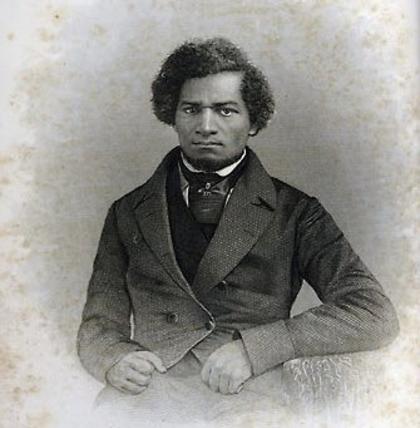Frederick Douglass
The North Star was founded by abolitionist Frederick Douglass. An integral part of the history of The North Star, Douglass's history is important to understanding the purpose and creation of the paper.
Early Life and Enslavement

Frederick Douglass
Douglass was into slavery in 1817 or 1818 to mother Harriet Bailey. Although unconfirmed, it is theorized that Douglass's master, Aaron Anthony, was also his father (Delbanco). After the death of Anthony, Douglass was willed to Anthony's son Thomas Auld. Despite being officially owned by Thomas, Douglass was traded back and borth between Thomas and his brother, Hugh Auld (Delbanco). Between the two households, Douglass was treated in varying manners. Sometimes he was like a son, sometimes simply a servant, and sometimes an inhuman piece of property (Delbanco).
Despite its illegality in other areas, slaves were allowed to read and write in Baltimore, MD, where Hugh Auld's family lived. Due to this, Douglass was taught the basics of reading and writing by Auld's wife, Sophia. Although Hugh demanded she stop, Douglass continued to secretly teach himself through observation (Delbanco).
Escape
Initially, Douglass hoped to buy his own freedom by saving the little amount of money he earned when hired out. However, slaves in the North were constantly at risk of being sold South (the dreaded downriver), so he planned to escape. Douglass's initially intended to escpae in 1836, but his co-conspirators lost their nerve and he was forced to delay his plans (Delbanco). Finally, he was given the opportunity in September 1838. After acquiring identification papers from a free black seaman, Douglass travelled through Delaware and Pennsylvania, eventually reaching New York City, where he was sheltered by the Underground Railroad (Delbanco).
Once free, Douglass's first job was a preacher at the African Methodist Episcopal Zion Church in New Bedford, MA (Park). In addition to bringing him back to his childhood ties to religion, Douglass's job as a preacher influenced his later writing. Analysis of his speaking and writing shows the Biblical influences in both his style and references, and his knowledge of religion allowed him to critically analyze the hypocrisy of slaveholders who claimed to be Christian (Park).
Abolition

Rendition of Douglass speaking
Douglass's career in abolition began in spring of 1839, when he attended an anti-slavery meeting to hear William Lloyd Garrison speak (Delbanco). After two years and several more conferences, he began speaking. Soon after, Douglass embarked on a speaking tour through the North, where he was celebrated in some places but treated poorly in others (Delbanco).
Despite being able to share his story, Douglass's speaking came with restrictions. He was told by his white "colleagues" that he was there to tell his story, not interpret or analyze slavery itself. In fact, any thinking of his was dismissed (Delbanco). Even his speaking was censored, such as when he was told to change his speech patterns to seem less educated than he was. Douglass himself didn't particularly want to talk about the specific horrors of slavery; according to him, he hated "slavery, not its mere incidents" (Delbanco).
Although Douglass's career was not what he hoped, he grew in fame and reputation as an abolitionist and activist. He was once described as "the most famous black exhibit of the 19th century," with his stories of floggings being amongst the "most sought-after forms of 19th century pornography" (Delbanco). With this fame and reputation, Douglass was able to get the funding to start his newspaper, The North Star.